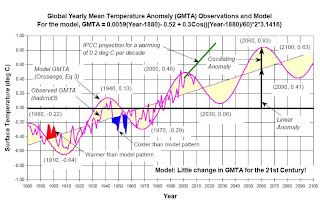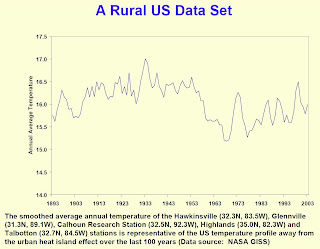
Während des Klimaoptimums des Holozän lagen die Temperaturen um mehrere Grad Celsius über den heutigen Werten. Dem entsprechend verlief während der drei Jahrtausende des Klimaoptimums die Baumgrenze in den Alpen 200 bis 300 m höher, in Sibirien und Nordamerika 300 km weiter nördlich als heute. Der Meeresspiegel war zu jener Zeit 2 m höher als in der Gegenwart. "Since the Holocene Optimum about eight thousand years ago, we have been in long term temperature decline at about 0.25 degrees per thousand years." (David Archibald, op. cit.) Die jüngste globale Erwärmung ist also in unserer Zwischeneiszeit nichts Außergewöhnliches.
Die nächste Grafik zeigt die globalen Temperaturen seit 1880 und versucht eine Trendextrapolation bis zum Jahre 2100 (Quelle: Girma Orssengo, Predictions Of Global Mean Temperatures & IPCC Projections):

Wir sehen, dass die globale Temperaturentwicklung in Erwärmungs- und Abkühlungsphasen von jeweils 30 Jahren verläuft. In den 120 Jahren vor der Jahrtausendwende gab es zwei Abkühlungsperioden, eine von 1880 bis 1910 und die andere von 1940 bis 1970; sowie zwei Erwärmungsperioden, eine von 1910 bis 1940 und die andere von 1970 bis 2000. Während des gesamten Zeitraums nahm aber die Konzentration von CO2 in der Atmosphäre ständig zu. Es gibt deshalb für die Hälfte des Beobachtungszeitraums keine Korrelation zwischen diesem Treibhausgas und dem Temperaturverlauf. Die beiden Abkühlungsphasen widerlegen die herrschende Klimalehre. "...comparison of observed increase in human emission of CO2 with increase in GMTA [Global Mean Temperature Anomaly] during the 20th century shows no relationship between the two. As a result, the claim by the IPCC of climate catastrophe is not supported by the data." (Girma Orssengo, op. cit.) Der Trend zu langfristig steigenden Temperaturen besteht seit dem Dalton Minimum der Kleinen Eiszeit und hat deshalb nichts mit den viel später einsetzenden technischen Kohlendioxidemissionen zu tun, sondern ist Teil eines langfristigen natürlichen Klimazyklus.
Die obige Grafik beruht auf der Auswertung der Daten von Bodenmessstationen, deren Mehrheit durch falsche Standortwahl dem städtischen Hitzeinseleffekt ausgesetzt ist und deshalb systematisch zu hohe Temperaturen angibt. Es lohnt sich daher, die Messungen von Stationen im ländlichen Raum, die vom städtischen Hitzeinseleffekt nicht beeinflusst sind, mit den urbanen Messreihen zu vergleichen. Die folgende Grafik zeigt die Werte von fünf Messstellen in den ländlichen USA von 1893 bis 2003 (Quelle: David Archibald, op. cit.):

Die außerstädtischen Messwerte aus den USA zeigen, dass es zumindest dort zu Beginn des 21. Jahrhunderts kühler war als in den 1930er-Jahren. "The 1.5° temperature decline from the late 1950s to the mid-70s was due to a weak solar cycle 20 after a strong solar cycle 19." (David Archibald, op. cit.) Diese Entwicklung ist weltweit zu beobachten. So war es in Grönland vor achtzig Jahren deutlich wärmer als heute. Der angeblich dominante Klimafaktor Kohlendioxid scheint nur sehr selektiv zu wirken.
"In fact, there is increasing evidence that much of the increase in ground temperature measurements during the 1980s and early 1990s may be more the result of the urban heat island effect, the poor placement of measuring instruments, and even attempts by the compilers of temperature data to manipulate the ground-based station data than it is of actual temperature increases." (Alan Carlin, A Multidisciplinary, Science-Based Approach to the Economics of Climate Change, International Journal of Environmental Research and Public Health, 2011, 8, 985-1031; doi:10.3390/ijerph8040985) Eine Fülle von Beweisen für diese Vermutung liefern Joseph D’Aleo und Anthony Watts in ihrem Artikel Surface Temperature Records: Policy-Driven Deception?, wo sie feststellen:
- "Instrumental temperature data for the pre-satellite era (1850-1980) have been so widely, systematically, and uni-directionally tampered with that it cannot be credibly asserted there has been any significant 'global warming' in the 20th century.
- All terrestrial surface-temperature databases exhibit signs of urban heat pollution and post measurement adjustments that render them unreliable for determining accurate long-term temperature trends.
- All of the problems have skewed the data so as greatly to overstate observed warming both regionally and globally.
- Global terrestrial temperature data are compromised because more than three-quarters of the 6,000 stations that once reported are no longer being used in data trend analyses.
- There has been a significant increase in the number of missing months with 40% of the GHCN [Global Historical Climatology Network] stations reporting at least one missing month. This requires infilling which adds to the uncertainty and possible error.
- Contamination by urbanization, changes in land use, improper siting, and inadequately-calibrated instrument upgrades further increases uncertainty.
- Numerous peer-reviewed papers in recent years have shown the overstatement of observed longer term warming is 30-50% from heat-island and land use change contamination.
- An increase in the percentage of compromised stations with interpolation to vacant data grids may make the warming bias greater than 50% of 20th-century warming.
- In the oceans, data are missing and uncertainties are substantial. Changes in data sets introduced a step warming in 2009.
- Satellite temperature monitoring has provided an alternative to terrestrial stations in compiling the global lower-troposphere temperature record. Their findings are increasingly diverging from the station-based constructions in a manner consistent with evidence of a warm bias in the surface temperature record."
Sehen wir uns die Satellitendaten an, die seit 1978 zur Verfügung stehen (Quelle: Arno Arrak, Satellite Data Show No Warming Before 1997. Changes Since Not Related to CO2, zitiert nach Alan Carlin, op. cit.):

Die Grafik zeigt die wirklich weltweiten Temperaturmessungen in der unteren Troposphäre durch die Satelliten, die von der University of Alabama in Huntsville (UAH) und dem Unternehmen Remote Sensing Systems (RSS) betreut werden. Gemessen wird mit einer Microwave Sounding Unit (MSU). Es fällt auf, dass die von den Satelliten gemessenen Temperaturschwankungen mit den periodischen Oszillationen im Pazifik, El Niño (Erwärmung) and La Niña (Abkühlung) genannt, übereinstimmen. Die gelben Punkte in der Grafik bezeichnen die Mitte zwischen diesen ozeanischen Ereignissen. Man sieht, dass von 1978 bis 1997 die Durchschnittstemperatur konstant geblieben ist.
"The record shows global climate oscillations with a period of three to five years and a peak-to-peak amplitude of 0.4 to 0.5 degrees Celsius about a common, fixed mean temperature that lasted from 1978 to 1997. Since this mean temperature did not change for twenty years the late twentieth century warming touted by IPCC and others simply did not happen. The cause of these newly discovered climate oscillations is large-scale periodic movement of ocean waters from shore to shore, part of the El Niño - Southern Oscillation (ENSO) system." (Arno Arrak, op. cit.) Die globalen Zirkulationsmodelle des IPCC berücksichtigen weder die ENSO noch andere periodische ozeanische Oszillationen und sind deshalb nicht in der Lage, das gegenwärtige Wetter zu erklären oder das künftige vorherzusagen.
Der außergewöhnlich starke El Niño von 1998 kann nicht durch das atmosphärische Kohlendioxid erklärt werden. Danach blieben die Temperaturen in der unteren Troposphäre auf einem etwas höheren Niveau konstant, obwohl in diesem Zeitraum die CO2-Konzentration zunahm. "Carbon dioxide cannot explain the lack of warming in the eighties and nineties, nor any of the abrupt warmings that followed, nor the stasis of the twenty first century high, nor the temperature downturn that followed it in 2007 and bottomed out in 2008." (Arno Arrak, op. cit.) Wohin man auch blickt, in den Temperaturdaten ist keine Spur der Treibhausgase zu finden.



Keine Kommentare:
Kommentar veröffentlichen